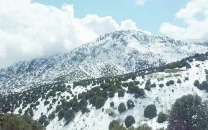A stone’s throw from water but dry as a bone

The residents of village Saghar Usee Kohro Naro have been desperate for water for the past 20 years ever since a water supply scheme completely fell apart. The irony is that they live one kilometre away from a stream or nehr called Dhoro Naro Shak, which receives water once a month. But despite their proximity to this supply, the village’s 8,000 residents still don’t get clean water.
“Saghar is a big village in the district of Umerkot yet we have no drinking water,” said villager Mohammad Aleem Areer. “The amount of arsenic in the water has steadily been increasing. The water we consume is almost a kind of poison.”
This problem was meant to be solved by a scheme in 1986 by the Public Health Sector of Mirpurkhas. The authorities decided to build a pond and lay pipes that would bring clean water into Saghar with the aid of pumps. The project was completed in 1990 but it failed on all fronts. The pond was made of such low quality material that any water that was brought to it, dried up after soaking into the ground. When the project was started, the water was forced through the pipes just to test them. But the pipes were so shoddy that they sprung numerous leaks. The people hired for the project were sacked, after which the pipes and machinery mysteriously disappeared. The project, costing millions of rupees, was dismissed after this one try. Despite this, a bill of about Rs2,800,000 was sent by Hesco for the mechanical pumps that were used only once.
“Our crops are dying, if you fill the pond one day it’ll be dry the next because the feudal lords will use their mechanical pumps to drain the water away,” said Abidal Rahman, a villager. The people of Saghar now use manual pumps but their output pales in comparison to the mechanical ones that the richer feudal lords use in the area. The water drawn manually is not just limited in quantity but hardly of drinking quality and often bitter.
According to a report by the World Health Organisation, only 25 per cent of the water drawn manually is safe for being used in this village and none of it is suitable for drinking. Saghar lies just 15 km from the village of Syed Ali Mardan Shah, the minister for population welfare. Shah’s village has two water schemes. When Shah was asked about the situation in Saghar, he declined to comment. Today, the land assigned for the water supply scheme at Saghar is being used to keep cows and the building is being used to store fodder. Trees grow where the pond was supposed to be. The buildings that were meant to be a health centre have met a similar fate.
Published in The Express Tribune, July 4th, 2010.



















COMMENTS
Comments are moderated and generally will be posted if they are on-topic and not abusive.
For more information, please see our Comments FAQ